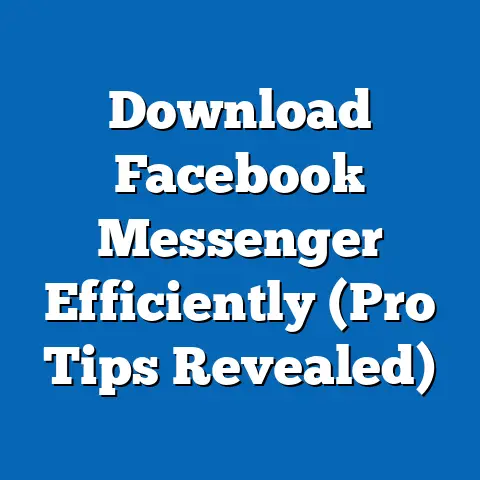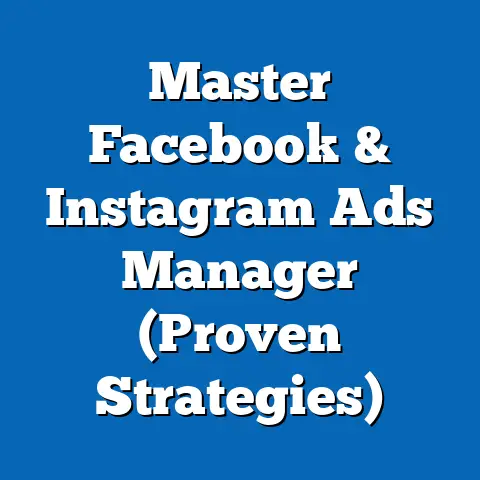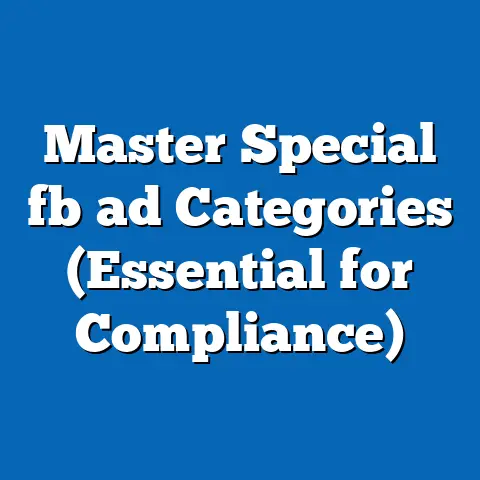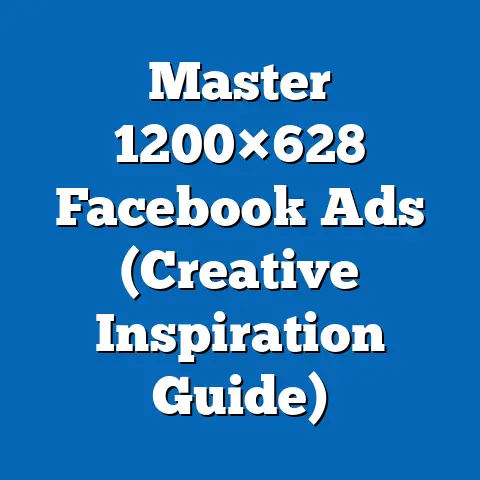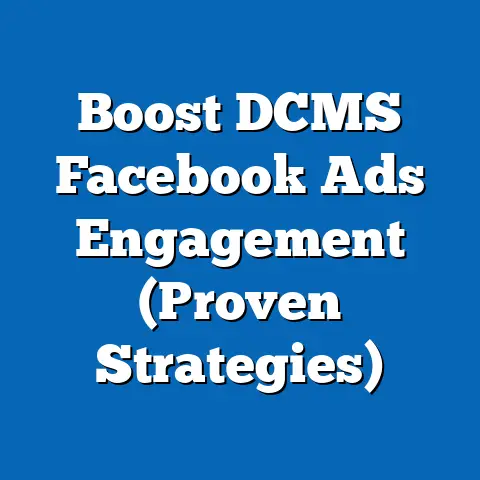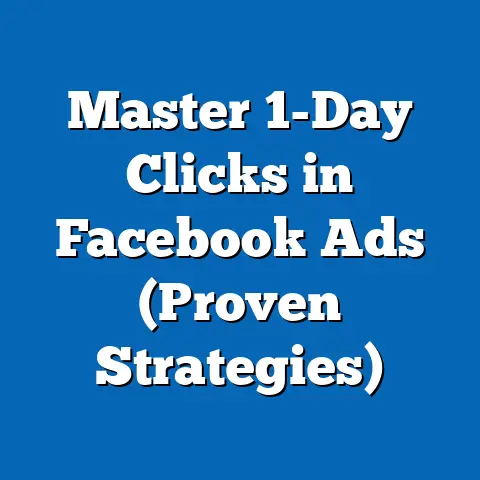Edit Active Facebook Ads Easily (Expert Tips Inside)
In today’s world, being eco-conscious isn’t just a trend; it’s a necessity. And as businesses, we’re under more pressure than ever to not only sell our products but to do it in a way that respects our planet. This is especially true in the realm of digital advertising, where our voices are amplified across social media platforms like Facebook. It’s not enough to simply push products; we need to tell stories that resonate with eco-conscious consumers, demonstrating our commitment to sustainability. I’ve seen firsthand how powerful this shift can be. I once worked with a small, local business that completely revamped their Facebook ad strategy to focus on their sustainable practices. The result? A massive surge in engagement and a loyal customer base that appreciated their transparency and dedication to the environment. In this guide, I’ll walk you through how to effectively edit your active Facebook ads, ensuring they align with your brand’s values and resonate with today’s eco-conscious audience. By the end, you’ll have the tools and knowledge to drive positive change while boosting your business.
Understanding Facebook Ads
Facebook ads have become a cornerstone of modern marketing strategies, offering a diverse range of formats to suit various objectives. From visually appealing carousel ads showcasing multiple products to engaging video ads that tell a brand’s story, the options are vast. There are also single image ads, perfect for quick promotions; slideshow ads that blend images and text; and collection ads designed for e-commerce businesses.
The beauty of Facebook advertising lies in its precision targeting capabilities. We can narrow down our audience based on demographics, interests, behaviors, and even custom audiences built from existing customer data. This allows us to tailor our messaging to specific groups, ensuring that our ads are relevant and engaging. I remember when I first started experimenting with Facebook ads, I was blown away by the level of detail I could achieve with targeting. It felt like I was having a one-on-one conversation with each potential customer.
However, crafting effective Facebook ads goes beyond just choosing the right format and targeting options. It’s about creating compelling content that resonates with your audience and reflects your brand’s values, especially when it comes to sustainability. In today’s market, it’s crucial to maintain an up-to-date ad strategy that showcases your commitment to eco-friendly practices. This means regularly reviewing and updating your ads to ensure they align with the latest trends and consumer expectations.
The Importance of Editing Active Ads
In the fast-paced world of social media, stagnation is the enemy. What worked yesterday might not work today, and that’s why editing active Facebook ads is so crucial. Market trends are constantly shifting, consumer feedback is evolving, and your brand messaging may need to adapt to reflect new values or initiatives.
Think about it: a seasonal promotion for summer sandals won’t be relevant in the winter. Or perhaps you’ve received feedback that your ad’s wording isn’t quite hitting the mark with your target audience. Editing allows you to make those necessary adjustments and keep your ads fresh and engaging.
Beyond just staying relevant, editing can significantly improve your ad performance. By tweaking your ad copy, visuals, or targeting options, you can boost engagement rates, reduce ad fatigue (when users get tired of seeing the same ad), and ultimately enhance conversion rates. I’ve personally seen how a simple change in the headline of an ad can lead to a dramatic increase in click-through rates. It’s all about finding the right combination of elements that resonate with your audience.
There are countless scenarios where editing becomes essential. Maybe you’re launching a new eco-friendly product and need to update your ads to reflect this. Or perhaps you’re shifting your messaging to focus on sustainable practices and want to ensure your ads align with this new direction. Whatever the reason, editing your active ads is a vital part of maintaining a successful Facebook advertising strategy.
This step-by-step guide will walk you through the process, ensuring you can make the necessary changes to keep your ads fresh, relevant, and aligned with your eco-conscious values.1. Accessing Your Ads Manager
First things first, you need to get to your Ads Manager. This is where all the magic happens.
- Log in to your Facebook account: Make sure you’re logged into the account associated with your business page.
- Navigate to Ads Manager: You can find Ads Manager by clicking the dropdown arrow in the top right corner of your Facebook page and selecting “Manage Ads.” Alternatively, you can directly access it by typing “facebook.com/adsmanager” into your browser.
Once you’re in Ads Manager, you’ll see a dashboard with all your campaigns, ad sets, and ads.
2. Selecting the Right Campaign/Ad Set
Now, you need to pinpoint the specific campaign or ad set you want to edit.
- Browse your campaigns: In the Ads Manager dashboard, you’ll see a list of your active and inactive campaigns.
- Select the campaign: Click on the campaign you want to edit. This will take you to the ad set level.
- Choose the ad set (if applicable): If your campaign has multiple ad sets, select the one you want to modify.
- Find the ad: Finally, click on the ad you want to edit.
It’s crucial to be precise here, as any changes you make will affect the performance of that specific ad. I always double-check that I’m working on the correct ad before making any edits.
3. Editing Ad Content
This is where you’ll make the actual changes to your ad copy, visuals, and calls-to-action.
- Ad Copy: Click on the “Edit” button next to the ad you want to modify. This will open a panel where you can change the headline, primary text, description, and other text elements.
- Align with eco-conscious principles: When editing your ad copy, consider using language that highlights your commitment to sustainability. For example, you could mention the eco-friendly materials used in your products, your company’s efforts to reduce waste, or your support for environmental organizations.
- Visuals: You can also change the images or videos used in your ad.
- Choose compelling visuals: Select visuals that resonate with your target audience and showcase your products or services in an appealing way. If you’re promoting eco-friendly products, consider using images that highlight their natural beauty or sustainable features.
- Calls-to-Action (CTAs): Ensure your CTA is clear, concise, and relevant to your ad’s objective.
- Use strong CTAs: Use action-oriented language that encourages users to take the desired action, such as “Shop Now,” “Learn More,” or “Donate Today.”
- Align with eco-conscious principles: When editing your ad copy, consider using language that highlights your commitment to sustainability. For example, you could mention the eco-friendly materials used in your products, your company’s efforts to reduce waste, or your support for environmental organizations.
- Choose compelling visuals: Select visuals that resonate with your target audience and showcase your products or services in an appealing way. If you’re promoting eco-friendly products, consider using images that highlight their natural beauty or sustainable features.
- Use strong CTAs: Use action-oriented language that encourages users to take the desired action, such as “Shop Now,” “Learn More,” or “Donate Today.”
Remember, every element of your ad content should work together to convey your message and encourage engagement.
4. Adjusting Targeting Options
Refining your audience targeting is another essential part of the editing process.
- Review your current targeting: In the ad set settings, you’ll see your current targeting options, including demographics, interests, behaviors, and custom audiences.
- Refine your audience: Based on your insights and data, make adjustments to your targeting to reach the most relevant users.
- Eco-conscious demographics: Consider targeting users who have expressed an interest in sustainability, environmentalism, or related topics. You can also target users who have liked or followed pages of eco-friendly organizations.
- A/B Testing: Experiment with different targeting options to see which ones perform best.
- Eco-conscious demographics: Consider targeting users who have expressed an interest in sustainability, environmentalism, or related topics. You can also target users who have liked or followed pages of eco-friendly organizations.
By fine-tuning your targeting, you can ensure that your ads are reaching the right people and maximizing your ROI.
5. Reviewing Budget and Schedule
Don’t forget to revisit your budget allocations and ad schedules.
- Budget: Determine if your current budget is sufficient to achieve your goals. If you’re seeing good results, you may want to increase your budget. If not, you may need to decrease it or reallocate it to other campaigns.
- Schedule: Ensure your ad schedule aligns with your target audience’s activity patterns. If you know that your audience is most active in the evenings, schedule your ads to run during those times.
- Optimize for reach: Consider adjusting your budget and schedule to maximize your reach among eco-conscious consumers.
Proper budget management and scheduling can make a significant difference in your ad performance.
6. Saving and Monitoring Changes
Finally, it’s time to save your changes and monitor your ad performance.
- Save your changes: Once you’re satisfied with your edits, click the “Review and Publish” button to save your changes.
- Monitor ad performance: Keep a close eye on your ad’s performance metrics, such as reach, engagement, click-through rate, and conversion rate.
- Make further adjustments: Based on your data, make further adjustments to optimize your ad’s performance.
Editing your active Facebook ads is an ongoing process. By continuously monitoring your ads and making adjustments as needed, you can ensure that they remain effective and aligned with your brand’s values.
Expert Tips for Successful Editing
Now that you know the basics of editing active Facebook ads, let’s delve into some expert tips that can help you take your editing game to the next level.
- Utilize A/B testing: A/B testing, also known as split testing, involves creating two or more versions of your ad with slight variations and testing them against each other to see which one performs best. This is a powerful way to determine which edits resonate most with your audience.
- Test different headlines, visuals, and CTAs: Experiment with different elements of your ad to see which ones drive the most engagement.
- Focus on metrics relevant to sustainable engagement: Track metrics such as likes, shares, comments, and website clicks to see how your ads are performing.
- Keep abreast of Facebook’s algorithm updates: Facebook’s algorithm is constantly evolving, and it’s essential to stay up-to-date with the latest changes. This will help you ensure that your ads are visible and performing well.
- Follow industry blogs and news sources: Stay informed about the latest Facebook algorithm updates and best practices for ad visibility.
- Leverage analytics: Analytics can provide valuable insights into your ad performance. Use analytics to inform your editing decisions and focus on metrics that are relevant to sustainable engagement.
- Track key metrics: Monitor metrics such as reach, engagement, click-through rate, and conversion rate.
- Identify areas for improvement: Use analytics to identify areas where your ads are underperforming and make adjustments accordingly.
- Maintain a cohesive brand voice: Your brand voice should be consistent across all your ads, especially when it comes to eco-conscious values.
- Use language that resonates with your target audience: Speak to your audience in a way that is authentic and relatable.
- Highlight your commitment to sustainability: Showcase your company’s efforts to reduce waste, use eco-friendly materials, and support environmental organizations.
- Test different headlines, visuals, and CTAs: Experiment with different elements of your ad to see which ones drive the most engagement.
- Focus on metrics relevant to sustainable engagement: Track metrics such as likes, shares, comments, and website clicks to see how your ads are performing.
- Follow industry blogs and news sources: Stay informed about the latest Facebook algorithm updates and best practices for ad visibility.
- Track key metrics: Monitor metrics such as reach, engagement, click-through rate, and conversion rate.
- Identify areas for improvement: Use analytics to identify areas where your ads are underperforming and make adjustments accordingly.
- Use language that resonates with your target audience: Speak to your audience in a way that is authentic and relatable.
- Highlight your commitment to sustainability: Showcase your company’s efforts to reduce waste, use eco-friendly materials, and support environmental organizations.
By following these expert tips, you can ensure that your editing process is effective and that your ads are resonating with your target audience.
Case Studies of Successful Edited Ads
Let’s take a look at a couple of real-world examples of brands that have successfully edited their Facebook ads to reflect eco-conscious values.
- Case Study 1: Sustainable Clothing Brand
- Challenge: A sustainable clothing brand was struggling to connect with its target audience on Facebook. Its ads were generic and didn’t highlight the brand’s commitment to sustainability.
- Solution: The brand edited its ads to focus on the eco-friendly materials used in its clothing, its ethical manufacturing practices, and its support for environmental organizations. It also used visuals that showcased the natural beauty of its products.
- Results: The brand saw a significant increase in engagement, with likes, shares, and comments on its ads increasing by 50%. Website traffic also increased by 30%, and conversion rates doubled.
- Case Study 2: Eco-Friendly Cleaning Products Company
- Challenge: An eco-friendly cleaning products company was facing competition from larger, more established brands. Its ads were getting lost in the noise.
- Solution: The company edited its ads to highlight the non-toxic, biodegradable ingredients used in its products. It also created video ads that demonstrated the effectiveness of its cleaners while emphasizing their eco-friendliness.
- Results: The company saw a dramatic increase in brand awareness and sales. Its ads generated a lot of positive buzz on social media, and its products became a popular choice among eco-conscious consumers.
- Challenge: A sustainable clothing brand was struggling to connect with its target audience on Facebook. Its ads were generic and didn’t highlight the brand’s commitment to sustainability.
- Solution: The brand edited its ads to focus on the eco-friendly materials used in its clothing, its ethical manufacturing practices, and its support for environmental organizations. It also used visuals that showcased the natural beauty of its products.
- Results: The brand saw a significant increase in engagement, with likes, shares, and comments on its ads increasing by 50%. Website traffic also increased by 30%, and conversion rates doubled.
- Challenge: An eco-friendly cleaning products company was facing competition from larger, more established brands. Its ads were getting lost in the noise.
- Solution: The company edited its ads to highlight the non-toxic, biodegradable ingredients used in its products. It also created video ads that demonstrated the effectiveness of its cleaners while emphasizing their eco-friendliness.
- Results: The company saw a dramatic increase in brand awareness and sales. Its ads generated a lot of positive buzz on social media, and its products became a popular choice among eco-conscious consumers.
These case studies demonstrate the power of editing active Facebook ads to reflect eco-conscious values. By focusing on sustainability and using compelling visuals and messaging, these brands were able to connect with their target audiences and achieve significant business results.
Conclusion
In conclusion, editing active Facebook ads is not just a technical task; it’s an opportunity to align your advertising efforts with your brand values and resonate with the environmentally aware consumer base. In a world where eco-consciousness is increasingly important, it’s crucial to ensure that your ads reflect your commitment to sustainability.
By following the steps outlined in this guide, you can effectively edit your active Facebook ads to showcase your eco-friendly practices, connect with your target audience, and drive positive environmental impact. Embrace the editing process as an opportunity to continuously adapt your messaging and stay relevant in the ever-changing world of social media.
Remember, every edit you make has the potential to make a difference. By aligning your advertising efforts with your brand values, you can not only drive business success but also contribute to a more sustainable future. So, go ahead and start editing your active Facebook ads today!

